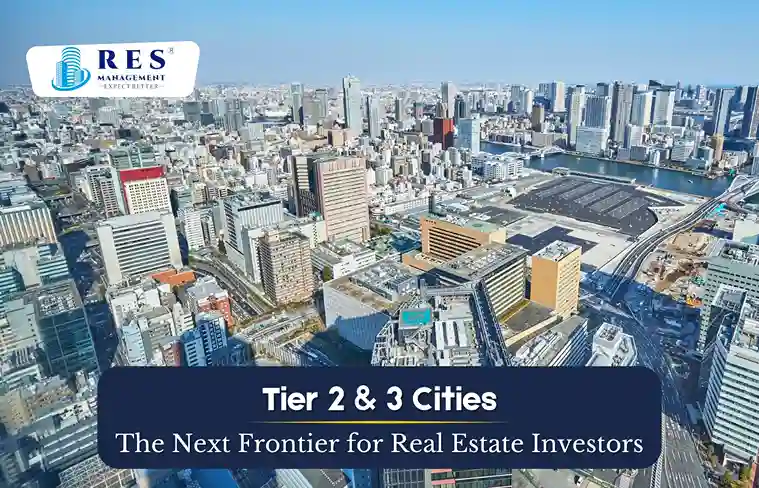
In the last few years, real estate investment in India has concentrated on the larger metropolitan areas — Mumbai, Delhi-NCR, Bengaluru, Chennai, Hyderabad, and Pune. However, in recent times, we have seen a movement of investors toward Tier 2/3 cities. Tier 2 cities typically include places like Ahmedabad, Jaipur, Lucknow, Coimbatore, Indore, and Chandigarh. Tier 3 cities include Bhavnagar, Nashik, Dehradun, Madurai, and Mysuru. These cities are attractive given their strong underlying growth fundamentals, improved connectivity, emerging policy, government regulations, and strong demand.
Why Make the Move?
Bigger growth potential & returns
Land values in metros are far too high—and have already risen significantly—meaning much of that upside in value has already been fully realized. Most Tier 2/3 cities have significant infrastructure programs at higher levels of maturity or not yet commenced, which bodes well for double-digit growth potential if the area develops successfully. The cost base is lower, so your entry point is more forgiving, and margins can be higher.
Infrastructure & connectivity improvements
The government is actively promoting urbanization across smaller cities via schemes like Smart Cities, AMRUT, and infrastructure development (roads, metro, and regional rapid transit). As these cities get plugged into national highways, rail, and better public transport, the value of real estate responds.
Demand shift & migration trends
The COVID era made work more flexible, and remote/hybrid working models have allowed people to live further from metros. There are many people who now prefer larger homes in smaller cities — providing less congestion, lower costs, and better quality of life. On the back of these lifestyle shifts, housing demand is rising in Tier 2/3 cities.
Investor sentiment & risk appetite
Some investors who previously adopted a more conservative approach to investing are now willing to take a chance for higher returns. Investors from Tier 1 markets are now actively looking at Tier 2 and 3 towns in pursuit of growth. However, metros will not lose their primacy — they still attract large capital flows and remain important in portfolios.
Institutional capital & leasing opportunities
The push toward income-generating, pre-leased assets is also expanding into smaller cities. Some developers are channeling investments from ultra-HNI (high net worth) and family offices into leasing models in Tier 2/3 locations. These provide stable returns rather than purely speculative value appreciation.
Challenges to watch out for
Regulatory & legal risk: Land titles, clearances, and approvals may be more opaque or complex in less-regulated regions.
Liquidity risk: It may take longer to buy/sell, particularly in smaller towns (lower market depth).
Development Quality: Trust and reputation are crucial, as poor delivery or delayed delivery can be detrimental to value.
Micro-location matters: Not every part of a Tier 2/3 city will grow; it’s key to be close to major roads, schools, and hubs.
Tips for investors
Conduct thorough due diligence into infrastructure pipelines, town master plans, zoning changes, and local government incentives.
Favor developers with previous successful histories of development in selected areas.
Diversify — don't put all your capital in one city or project.
A mix of residential + lease/rental yield is a strong balance of capital growth + income.
Have an exit strategy - even in the Tier 2/3 market - make sure you have an exit plan in case the resale or secondary buyer is needed.
Final Thoughts
Tier 2 and 3 cities are emerging as one of the most compelling real estate investment frontiers in India. They balance risk and reward in a way metros no longer can for many investors. With the right approach, they may well define the next decade’s winners in property investment.
RES Management can help you invest smartly in Tier 2/3 cities.
FAQ
1. Why invest in Tier 2/3 cities when metros still dominate?
While metros will continue to generate significant capital flows, they will also reach a point of saturation, combined with higher land prices and lower incremental upside. Tier 2/3 cities have more room to grow with a relatively higher yield and less direct competition. Investors are partly investing in this shift to so-called new "frontiers" where metros are too crowded to invest in.
2. Which types of real estate (residential, commercial, leasing) make sense in Tier 2/3 cities?
Residential housing is a natural choice. But also, leasing / income-generating assets (office, retail, co-living) are gaining traction, especially if a location has institutions, industrial corridors, or educational hubs.
3. How do I know if a tier 2/3 city is worth investing in?
Key considerations: planned infrastructure (roads, metro, transport), industrial or employment drivers (factories, special economic zones), population growth/migration trends, the regulatory environment of local government, good schools/amenities & liquidity risk.
4. What is the holding period one should expect?
Typically medium to long term (5–10 years). Growth is often steady, but a slower process often results in patience. In some cases, well-timed exits in 3–5 years may yield good upside if the city’s growth accelerates.
5. Are Tier 2/3 investments riskier?
Yes. Reduced liquidity risk, regulatory risks, developer risk, infrastructure delays, or underestimated growth assumptions. But many of these types of risks can be minimized as a result of good research, good local connections, and conservative planning.





